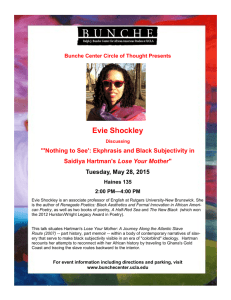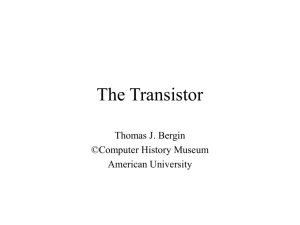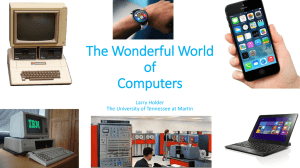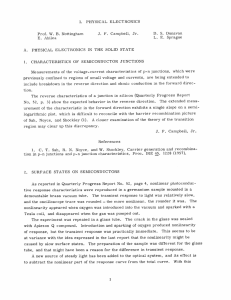william bradford shockley - National Academy of Sciences
advertisement
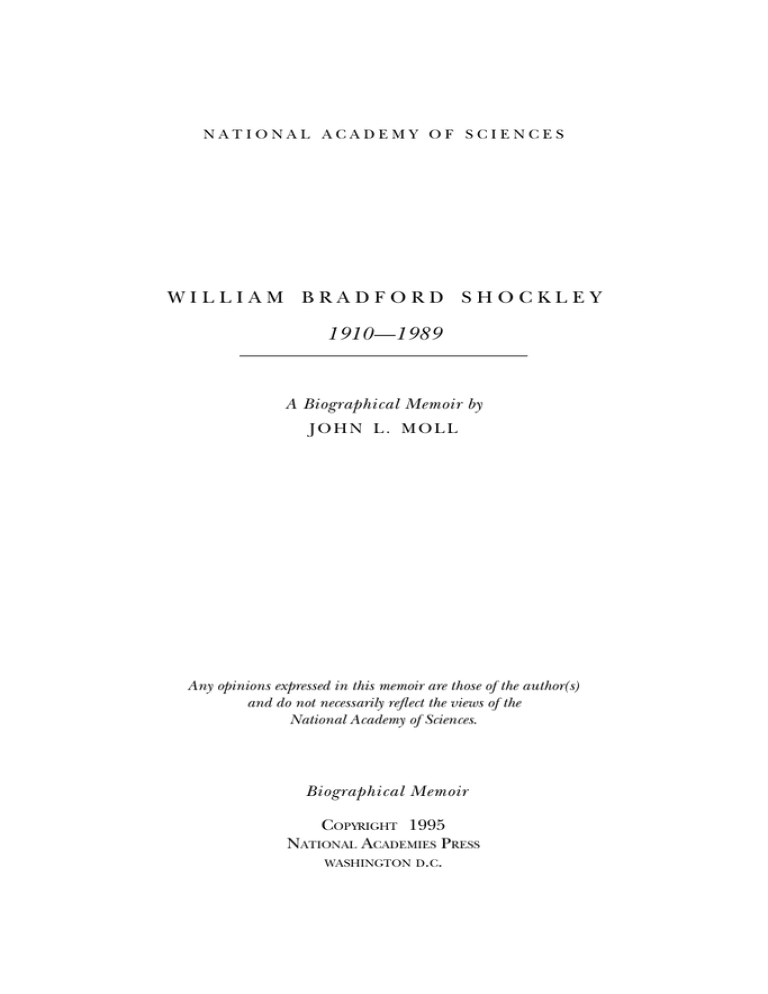
national academy of sciences W i l l i a m B r a d f o r d Sh o c k l e y 1910—1989 A Biographical Memoir by John L. Moll Any opinions expressed in this memoir are those of the author(s) and do not necessarily reflect the views of the National Academy of Sciences. Biographical Memoir Copyright 1995 National Academies Press washington d.c. WILLIAM BRADFORD SHOCKLEY February 13, 1910–August 12, 1989 BY JOHN L. MOLL W major participant in the physical discoveries and inventions that are the basis of the transistor era and the twentieth-century electronics industrial revolution. Transistor circuits are basic to almost all of our technological advances. Shockley was born in London, England, on February 13, 1910. His parents were Americans. His father, William Hillman Shockley, was a mining engineer, and his mother, the former May Bradford, had been a federal deputy surveyor of mineral lands. In 1933 Shockley married Jean Alberta Bailey. They had two sons, William and Richard, and a daughter, Alison Lanelli. They divorced in 1955, and in the same year Shockley married Emmy Lanning. When Shockley was three years old, the family returned to the United States and settled in Palo Alto, California. His parents considered that they could give their son a better education at home than in the public schools. They therefore kept him out of school until he was eight years old. His mother taught him mathematics, and both parents encouraged his scientific interests. Professor Perley A. Ross, a Stanford physicist and neighbor in Palo Alto, exerted an especially important influence in stimulating his interest in ILLIAM BRADFORD SHOCKLEY WAS A 305 306 BIOGRAPHICAL MEMOIRS science. Shockley was a frequent visitor at the Ross home, playing with the professor’s two daughters and becoming a substitute son. When he entered high school, Shockley spent two years at the Palo Alto Militar y Academy. He then enrolled for a brief time in the Los Angeles Coaching School to study physics. He finished his high school education at Hollywood High, graduating in 1927. He started his college education the same year at the University of California at Los Angeles. After a year at UCLA, he entered the California Institute of Technology in Pasadena. He had a number of outstanding teachers at CalTech. William V. Houston taught the introductory theoretical physics course. In addition, Richard C. Tolman and Linus Pauling were professors. Shockley earned his bachelor of science degree in physics in 1932. Shockley went to MIT on a teaching fellowship. He obtained his Ph.D. degree in 1936. His thesis title was “Calculation of Electron Wave Functions in Sodium Chloride Cr ystals.” The solid-state physics he learned at MIT proved to be the basis of his contributions to physics and electronics. An account of an acquaintanceship between Fred Seitz and Shockley has kindly been made available by Professor Seitz. This account covers their college days and includes items up to Shockley’s later years. I am including it with his permission in an almost unedited form: One of Slater’s students was William Shockley whom I had known since [my] undergraduate days. Among other things, Shockley demonstrated, with the use of an empty lattice model, that the precise determination of band gaps for real crystals with the use of the cellular method would require highly evolved techniques. Shockley went on to join the Bell Telephone Laboratories where, along with Bardeen and Brattain, he played such an important role in the invention of the transistor after World War II. WILLIAM BRADFORD SHOCKLEY 307 While on the Stanford campus in August of 1932 and in the initial phases of making plans to return to New Jersey, Mrs. Ross approached me to say that Mrs. Shockley, the mother of William Shockley, had called her from Hollywood to say that her son had received an appointment at the Massachusetts Institute of Technology and was planning to drive east with his De Soto convertible. Would I care to drive with him and share the costs? I agreed. Thus began one of the most carefree two-week periods I have enjoyed in the intervening decades. Shockley, I soon realized, was then strongly influenced by the Hollywood culture of the time, fancying himself to be a cross between Douglas Fairbanks, Sr. and Bulldog Drummond with perhaps a dash of Ronald Coleman. Moreover, he accepted pronouncements of the Hollywood stars on political, social and economic issues with the same degree of seriousness that I would have taken of those of Governor Rolph or President Hoover. Moreover, he had a loaded pistol in the glove compartment. I was then handy with a rifle but looked askance at the pistol. Shockley’s special air and the pistol eventually brought him to grief as he drove through Newark, New Jersey on the very ancient Route 1 of that day, after leaving me off at Princeton where he spent a day. He was spotted by the Newark police who took him to be a suspicious character. The pistol clinched the matter. He never gave me the details but he evidently had a difficult interview with the Newark judge who [made] very imaginative use of the English language. We selected the southern route through Arizona, New Mexico, Texas and Arkansas, eventually reaching the Lincoln Highway in Ohio. Along the way, we visited Carlsbad Caves and the Kentucky Caves including the then famous Floyd Collins Crystal Cave in Kentucky. This had been discovered by Collins who, somewhat later, had been entrapped and killed in a further attempt at cave exploration—one that was featured for days in the national press as rescuers tried in vain to reach him before he died. His presumed body was on exhibit in a glass covered coffin, although I must admit that the object we witnessed looked surprisingly like a dummy in a very inexpensive clothing store. The guide, however, assured us on its authenticity declaring, “He was, as you can see, a very handsome man.” We also encountered torrential rains in Texas after leaving Carlsbad Caverns in New Mexico. The rains were so heavy that the highway was obliterated. We parked the car off the highway at a rise and spent the night wandering through the desert. This gave Shockley an opportunity to fire his pistol on several occasions when he decided to ward off the possibility 308 BIOGRAPHICAL MEMOIRS of meeting serious danger from a group of coyotes howling in the distance. It also caused a gasoline station attendant at a nearby store to declare to us the next morning that the local police had been alerted to the fact that two desperadoes were loose in the area. He suggested we keep a lookout. Both of our careers were almost cut short by an incident that occurred as we were traversing the hills of Kentucky in the early evening on a narrow, two-lane road, one lane in each direction. I was driving and had a drop-off on my right. As we rounded a curve we found speeding down toward us two trucks which were racing one another and taking up both lanes. This race was evidently being run in a playful manner, typical of the spirited, young hill folks. By the grace of the Lord, I had just enough shoulder to squeeze by the oncoming truck with perhaps an inch to spare. To the best of my knowledge I have never been closer to instant death than in those few seconds. One might ask which, if any, of the most prominent attributes which would characterize Shockley later in life, when he was a famous scientist, were evident at this early stage of his career. It was clear from the start, of course, that he was unusually intelligent. His later fame, and indeed notoriety, rested upon two characteristics. First and foremost was the ability to seek out the core issues in a scientific problem and bring them to the surface in a dramatically clear way with the use of either theoretical or experimental measures—an ability which in some ways matched those of Enrico Fermi although in a different area of physics. In this respect, his most creative period occurred when he was at the Bell Laboratories and between about 1940 and 1955. Having known him quite early in his career, I was never surprised at this aspect of his creativity. Later on he attempted to apply his ability to the study of differences in the characteristics of ethnic groups, particularly differences in intelligence as measured in various ways. While objective studies of physiological or other differences in such groups clearly have a place in science, it is quite a different matter to advocate at the same time that any conclusions drawn from such work be used as a basis for actions, forceful or otherwise, with respect to eugenics. Here, unfortunately, Shockley became mired in a morass of his own making because of his second characteristic. He apparently was unable to place himself in the shoes of others and thereby understand that advocating strong eugenic measures in a highly diverse society is bound to be highly disruptive. Yet he advocated that such a course be followed to the very end of his life. Along with this was an unwillingness to admit that methods of analysis which work so well in relatively clear-cut WILLIAM BRADFORD SHOCKLEY 309 physical systems may become highly controversial and indeed counterproductive in other circumstances. I saw an inkling of this second characteristic at an early period but did not take it seriously then. He was inclined to believe that society should be governed by what one might regard as an intellectually elite group, not very well defined at this early stage, rather than by majority decisions as in a democratic society. Unlike many other intellectuals, he never coupled this belief to any ongoing political system, Marxist or Fascist. He was guided entirely by his own internal sense of logic. Early in 1933 William Hansen received an appointment at the Massachusetts Institute of Technology. Since Shockley wanted to drive west and Hansen wanted to participate in the advanced summer physics lecture series at the University of Michigan, the three of us started west together. The school at Michigan had not yet begun when we arrived but Robert Bacher, who held a postdoctoral position and was widely known for the book he and Samuel Goudsmit had published on atomic spectra, took us in hand and gave us an excellent tour of the department. At that time, he was in the midst of studying the hyperfine structure of atomic spectra derived from nuclear magnetic moments. Bacher was destined to play major roles in the future of American science. Five years later, then at Cornell University, he would, with Hans Bethe, prepare a series of excellent overviews of the status of nuclear physics which contained much original material. Ten years later he would play one of the central roles in the development of the bomb at Los Alamos followed by a period as a member of the Atomic Energy Commission. His career would be climaxed by an appointment to the California Institute of Technology in which he would serve as faculty member and one of President Lee DuBridge’s principal colleagues. Our return trip to the West Coast was routine with one notable exception. Shockley had switched the car registration from California to Massachusetts during the winter. Whereas we had been greeted warmly wherever we went on the way east with California plates, there was conspicuous hostility west of the Mississippi River. The people there were prepared to blame the irresponsible easterners for the great economic depression they were experiencing. Throughout his life Shockley maintained an interesting set of hobbies. Before I knew him he had been interested in slight of hand parlor tricks and maintained a great deal of skill over the years. He added a great deal of side interest to his student years at MIT by using his imagination 310 BIOGRAPHICAL MEMOIRS and sense of fun to keep the staff there on edge with subtle or not too subtle tricks. Many of my friends in industrial laboratories, being free of the academic responsibilities for teaching, committee assignments and the like, managed to find time for hobbies along with their creative work in the laboratory. Shockley was no exception. At one point this involved hand over hand rock climbing, at another far more sophisticated rope climbing including semi-professional assaults on some of the more difficult peaks in the vicinity of Mont Blanc. In addition, he had one highly solitary hobby that displayed a special side of his makeup. He enjoyed establishing confined ant colonies in large glass containers. Part of the art he cultivated was to train the ants to take circuitous routes in seeking food and returning to their storage base. This frequently involved the construction of delicately balanced seesaws of straws which would tilt under the weight of an ant. The ant, near its home base, would climb on the lowered end of such a straw and, in moving past the fulcrum, would cause the straw to tilt so that the ant could reach the food supply. Once the ant left the straw, the latter would return to its original position. This would compel the ant to find an alternate path back. The return path usually involved one or more such challenging seesaws. Shockley could spend hours at the game. In the latter part of the 1980s, a dean of engineering at one of the large South African universities, who frequently visited Stanford University where Shockley spent his later years, invited the latter to visit South Africa in order to give a speech commemorating the invention of the transistor. Knowing of Shockley’s controversial interest in studies of differences in ethnic groups, the dean emphasized that any presentation of his views on such matters would be completely inappropriate because the South African government was trying to find a way out of the morass it had entered into in setting up the laws concerning apartheid. Alas, when Shockley came to give his lecture he focused not at all on the transistor but on his personal views of the relative merits or demerits of various ethnic groups much to the great embarrassment of the audience and the dean. Shockley used a substantial part of his time in South Africa studying the trainability of local ants. When Shockley graduated from MIT he took a job at Bell Telephone Laboratories to work with Clinton J. Davisson. WILLIAM BRADFORD SHOCKLEY 311 Shockley’s first project involved the design of an electron multiplier tube. He quickly became involved in solid-state physics research. In 1939 he proposed a kind of “field effect transistor” that used wires imbedded in CuO2. The device as proposed has never worked, but a field effect device (invented in about 1960 by other people) has become the mainstay of the ultra-large-scale integrated circuit. The proposal that Shockley made in 1939 coincided with the laboratories’ goal of replacing the mechanical relays and vacuum tubes in the telephone exchange. Shockley turned to military projects during World War II. He was first employed on the electronic design of radar equipment at Bell Labs. He then became research director of the Antisubmarine Warfare Operations Research Group set up by the Navy Department at Columbia University. He was in the Naval Operations Research position from 1942 until 1944. The new field of operations research treated militar y objectives, such as optimum patterns for dropping depth charges against submarines and the time of aerial bombardments, as problems subject to scientific methods of analysis. From 1944 until 1945 he was an expert consultant to the office of the Secretary of War. In 1945 Shockley returned to Bell Labs. Mervin Kelly, president of the labs, had decided to set up a research group to understand semiconductors from a basic physical viewpoint. There seemed to be a real possibility that semiconductors could be used as electronic elements. Russell Ohl had a small laboratory at Bell Labs in Holmdel, New Jersey, where he “manufactured” point contact detectors for radar purposes during World War II. Ohl had an insatiable curiosity, and, in addition to supplying the radar detectors, he discovered numerous unique properties of the silicon crystals that were available to him at the time. He 312 BIOGRAPHICAL MEMOIRS demonstrated the photoelectric effect at a p-n junction, as well as other properties of crystals in relation to point contact detectors. These properties were not understood, except in an empirical sense. A research group was formed under the supervision of Shockley and Stanley Morgan, a chemist. Shockley’s job included the task of recruiting from inside as well as outside the labs. He was able to assemble a very competent group of researchers, including John Bardeen, Walter Brattain, Gerald Pearson, Morgan Sparks, and others. In 1946 Bell Labs was engaged in a 30 percent staff reduction from its wartime peak while simultaneously resuming its prewar research activity with new insights. This reduction was occurring at the same time that Shockley was starting his physical research on semiconductors. The application of quantum theory to solid-state physics in the decade of the 1930s had greatly advanced the knowledge of semiconductor properties, but much of the theory lacked confirmation by quantitative experiments. The radar systems used germanium and silicon point contact detectors during World War II. The material quality was greatly advanced in support of this application. Thus, the time was ripe for the task at hand. Although some members approached their work as pure research, from the beginning it was clearly Shockley’s goal to discover a solid-state amplifier as a replacement for the vacuum tube. Shockley returned to the idea of the field effect transistor, in which an externally applied electric field should, according to his calculations, modulate the current in a germanium filament, much as the grid in a vacuum tube controls the anode current. The experiments done to achieve this effect were never successful. John Bardeen suggested that electrons were trapped in surface states and thus prevented the electric field from penetrating the crystal. This WILLIAM BRADFORD SHOCKLEY 313 insight led to a series of experiments on surface effects, including the discovery of minority carrier injection by the point contact emitter by Bardeen and Brattain in 1947.1 The point contact transistor effect was demonstrated for Bell Labs management by Brattain and Bardeen on Christmas Eve 1947. The discovery of the first semiconductor amplifier by Bardeen and Brattain in Shockley’s department at Bell Labs, but without his participation, drove him to furious activity. Bardeen described the transistor action as minority carrier injection, but there was no clear proof that this was correct. In the process of devising an experimental test of the transistor action, Shockley invented the junction transistor. He reported on this device in a paper in the Bell System Technical Journal2 and gave a comprehensive review of the electronic behavior of semiconductors in a book in 1950.3 The junction transistor was more difficult to achieve than the point contact, and it was not until 1951 that it was first built. This series of events started the electronic revolution that is arguably the most important development of the twentieth century. There had been relevant theoretical work in England,4 Germany, 5 and Russia6 on the study of band structure and the theory of rectifiers, and the American war effort had supplied some theory as well as experiments to the overall picture.7 There were still many missing pieces to the puzzle, and the next few years involved many researchers of various disciplines trying to unravel the essence of the behavior of semiconductors. For example, the properties of both the negative electrons and positive holes had to be clarified in the fourth-column elements: germanium, silicon, and diamond. The facts are detailed in The History of Engineering & Science in the Bell System Electronics Technology, 1925-1975. The publication of Electrons and Holes in Semiconductors by Shockley 314 BIOGRAPHICAL MEMOIRS in 1950 was a bible to a generation of researchers and academicians. Shockley had always been a fast and unconventional thinker. His solutions to physical and mathematical problems were simultaneously unconventional, quick, and usually correct. He simply spun off new ideas that occupied experimenters for years. He organized a weekly meeting in the auditorium for the presentation of new results; there were so many that the time was always filled. This was a period of high excitement and intellectual achievement; Shockley was the keystone. His example spurred his fellow workers on. His ability to approach a difficult problem in a remarkably effective manner, to break the problem into its fundamental components, and to find an elegant solution was a strong factor in his approach to the general problem of achieving a more basic understanding of semiconductors. Shockley was adventuresome, professionally and as an individual. He published without waiting for experimental confirmation—and was usually proved correct. He was an enthusiastic amateur mountain climber. The Bell Labs cafeteria had a stone facade; at lunch time he would demonstrate his abilities by scaling the wall, gripping by his fingertips. His enthusiasm for high-speed driving put fear into his passengers. As an amateur magician, he once challenged the protocols of the august American Physical Society, finishing a speech at the annual meeting by “miraculously” producing and flaunting a full bouquet of roses. Unfortunately, his technical insights were counterbalanced by his lack of insight into human relations. This led to a major division within his own group, and ultimately he took paths that he should have avoided. It also accounts for some of the widely divergent views of Shockley that have been expressed by otherwise intelligent individuals. WILLIAM BRADFORD SHOCKLEY 315 Shockley maintained activities outside Bell Labs throughout most of his career. He was a visiting lecturer at Princeton in 1946 and at CalTech in 1954 and 1955. He also continued to serve the government, as scientific adviser for the Joint Research and Development Board from 1947 to 1949. He was deputy director of the Weapons Systems Evaluation Group of the Department of Defense in 1954 and 1955. In 1962 he became a member of the President’s Science Advisory Committee on Scientific and Technical Manpower. Shockley started the Shockley Semiconductor Laboratories in the Stanford industrial park in 1955 with help from the Beckman Instruments Company. This was the first semiconductor company in what is now Silicon Valley. The intent was to do research, development, and production of silicon switching devices. Shockley was a better scientist than businessman or manager. The Shockley labs were not a financial success. Shockley lacked the business acumen and market sense that was possessed by some of his employees; Bob Noyce, Gordon Moore, and a group of six other employees left Shockley to form Fairchild Semiconductor in 1957. Clevite Transistor purchased the operation in 1960. Shockley remained as a consultant. The company eventually closed in 1969. Fred Terman, then provost of Stanford University, was eager to see new industr y in the new electronics technology started near Stanford and was starting a parallel effort in the Stanford electrical engineering department. There were numerous informal connections between Shockley’s labs and the people who were starting Stanford’s semiconductor program. An arrangement was made whereby a new faculty member in electrical engineering spent an extended period working half time at the Shockley labs. Shockley had no official connection to the university when these half-time positions were set up. There was, neverthe- 316 BIOGRAPHICAL MEMOIRS less, an informal connection, with many professors and students meeting from time to time to discuss their ideas. Dealing with his personality was daunting to the typical doctoral candidate, but the strongest and most independent students derived great benefit from their interactions. Shockley’s association with Stanford became official in 1963, when he was appointed to be the first Alexander M. Poniatoff Professor of Engineering and Applied Science. He retired from Stanford in 1972. Shockley was in a serious automobile accident in July 1961. He said that while he was lying immobilized from the accident he read about a teenager with an IQ of 70 who had blinded a delicatessen owner with acid. This incident made him determined to expose the “dysgenics” that was occurring in our society. His approach to this exposition had many of the appearances of his approach to earlier scientific problems but on close examination lacked the scientific method. His methods and conclusions were highly controversial. The subject itself is charged with political and racial overtones. A great deal of data on the subject may have been fabricated or at least modified to suit a preconception. Shockley proposed some action on the topic by the National Academy of Sciences and was rejected. I believe that the combination of his strong personality and the rejection of action or support from fellow scientists made him determined to prove that his conclusions were right. In 1965 Shockley renewed his association with Bell Labs in the capacity of executive consultant. His interests expanded into new areas, particularly domain wall motion in ferrites. He worked first with H. J. Williams and then with Andrew Bobeck and his group. Shockley helped establish a new memory technology based on the controlled motion of small domains called magnetic bubbles. It was a complete WILLIAM BRADFORD SHOCKLEY 317 memory system but was unable to compete with the evolving semiconductor memories. In an interview on the eve of his retirement from Bell Labs in 1975 he was asked what recent technical developments he considered most important. There was no hesitation in his reply: One of the most striking things I’ve seen is the possibility of using gallium arsenide lasers and optical fibers in new transmission systems. Now you may observe that lasers and fibers will accomplish the same sorts of things as existing technology. But that’s exactly what the transistor did: replaced the vacuum tube but at tremendous advantages in cost, power, space, and reliability. In 1980 Shockley brought a $1.25 million libel suit against the Atlanta Constitution for an article it published about his ideas on race and intelligence. He accused the newspaper of “falsely and maliciously” likening his ideas to the Nazi genetics experiments in World War II. A token $1 in damages was awarded to him. He entered the 1982 Republican primary in California for the seat of retiring U.S. Senator S. I. Hayakawa. He was a single-issue candidate, warning of the threat of dysgenics. He came in eighth. In his later years Shockley was far more eager to talk about his theories on race and intelligence than his contributions to science. He died in 1989 at the age of seventy-nine. Shockley divided his life between creative science and engineering and his crusade against dysgenics. He devoted the last fifteen years of his life almost exclusively to dysgenics. The latter period increased the controversy that surrounded him. The topic of ethnic intelligence is controversial. Bill Shockley made no effort to calm the waters. His own behavior enhanced a tendency to judge him by his later years, where he was definitely dealing with a subject that would not yield to his method of attack. 318 BIOGRAPHICAL MEMOIRS Shockley led the effort in the Physical Research Department at Bell Labs for about ten years and many critical advances were accomplished during that period. He spent almost forty years making contributions to solid-state physics, was awarded over ninety patents for his inventions, and made many notable contributions to the scientific literature. His patents and publications alone do not measure his contribution to the advancement of technology. He certainly inspired a generation of scientists to great achievements. There are many testimonials to his capability of breaking a problem down to its fundamental components and finding unique solutions. A few public recognitions of his accomplishments are the Medal for Merit (1946); election to the National Academy of Sciences (1951); Air Force Association Citation of Honor for Outstanding Public Service (1951); Morris Liebmann Award (1953); Oliver Buckley Solid State Physics Prize (1953); Certificate of Appreciation from the Department of the Army (1953); and, with Bardeen and Brattain, the Nobel Prize in physics for inventing the transistor (1956). A memoir of Shockley is incomplete without discussion of the transistor invention. This purely scientific endeavor is surrounded by a certain amount of controversy. The importance of the transistor to our industry and to our continuing advancement keeps the controversy alive. The three Nobel Prize winners (Bardeen, Brattain, and Shockley) all made significant contributions to the invention. Discussions of this period of scientific history tend to raise a question of precedence between Bardeen and Shockley concerning the discover y of minority carrier injection. It is my considered conclusion that the events as I have given them are correct. The laborator y group that Shockley recruited was seeking to invent a solid-state amplifier. There was a possible field effect device that did not work. A series of ex- WILLIAM BRADFORD SHOCKLEY 319 periments were done by Brattain and Bardeen, very much with the knowledge and approval of Shockley, to find clues as to why the field effect device did not work. Experiments with gold dots evaporated on germanium led Bardeen to suspect that minority carrier injection was a factor in the surface experiments. These experiments led to the BardeenBrattain experiment, which was the point contact invention. The point contact device was the first carrier injection amplifier. Shockley’s activity in designing experiments to elucidate the physical processes in the point contact device led to the invention of the junction transistor. Both of these activities completely justified his receipt of the Nobel Prize. I CONSULTED MANY PEOPLE with intimate knowledge of the activities at Bell Laboratories in the late 1940s. Ken McKay was most helpful with his account of the air of excitement generated during this period of invention and discovery. Professor Fred Seitz filled in a crucial segment of Bill Shockley’s life. In addition, Morgan Sparks was very helpful in trying to recapture the early atmosphere. All of these people knew Bill Shockley before I did. I went to Bell Labs when I finished my Ph.D. at Ohio State in 1952, and most of the excitement of invention occurred between 1945 and 1950. NOTES These references give only a small part of the total work that was reported in Europe in the 1930s, but I believe they are adequate to demonstrate the starting point for the advances of the 1940s and 1950s. 1. J. Bardeen and W. Brattain. The transistor—a semiconductor triode. Phys. Rev. 74:(1948):230. 2. See Shockley (1949,2). 3. See Shockley (1950,1). 4. A. H. Wilson. Proc. Roy. Soc. 133A(1931):458. 5. W. Schottky and E. Spenke. Wiss. Veroff. aus die Siemens Werken 18(1939):1-67. 320 BIOGRAPHICAL MEMOIRS 6. B. Davidov. The rectifying action of semiconductors. Tech. Phys. (U.S.S.R) 5(1938):87-95. 7. H. C. Torrey and C. A. Whitmer. Crystal Rectifiers. New York: McGraw-Hill, 1948. The following references supplied much information for this memoir: R. Slater. Portraits in Silicon. Cambridge, Mass.: The MIT Press, 1987. T. Wasson, ed. Nobel Prize Winners. New York: H. W. Wilson Co., 1987. WILLIAM BRADFORD SHOCKLEY 321 SELECTED BIBLIOGRAPHY 1936 Electronic energy bands in sodium chloride. Phys. Rev. 50(8):75459. 1938 With J. R. Pierce. A theory of noise for electron multipliers. Proc. IRE 26(3):321-32. 1939 On the surface states associated with a periodic potential. Phys. Rev. 56(4):317-23. 1946 With J. Bardeen and W. H. Brattain. Investigation of oxidation of copper by use of radioactive Cu tracer. Phys. Rev. 70(1-2):105-6. 1948 With G. L. Pearson. Modulation of conductance of thin films of semi-conductors by surface charges. Phys. Rev. 74(2):232-33. 1949 With G. L. Pearson and J. R. Haynes. Hole injection in germanium—quantitative studies and filamentary transistors. Bell Syst. Tech. J. 28(3)344-66. The theory of p-n junctions in semiconductors and p-n junction transistors. Bell Syst. Tech. J. 28(3):435-89. With G. L. Pearson and M. Sparks. Current flow across n-p junctions. Phys. Rev. 76(1):180. 1950 Electrons and Holes in Semiconductors. Princeton, N.J.: Van Nostrand. With J. Bardeen. Energy bands & mobilities in monatomic semiconductors. Phys. Rev. 77(3):407-8. With W. T. Read. Dislocation models of crystal grain boundaries. Phys. Rev. 78(3):275-89. 322 BIOGRAPHICAL MEMOIRS With J. Bardeen. Deformation potentials and mobilities in non-polar crystals. Phys. Rev. 80(1):72-80. With H. J. Williams and C. Kittel. Studies of the propagation velocity of a ferromagnetic domain boundary. Phys. Rev. 80(6):109094. 1951 With J. R. Haynes. The mobility and life of injected holes and electrons in germanium. Phys. Rev. 81(5):835-43. With M. Sparks and G. K. Teal. p-n junction transistors. Phys. Rev. 83(1):151-62. 1952 With W. T. Reed, Jr. Statistics of the recombinations of holes and electrons. Phys. Rev. 87(5):835-42. Transistor electronics: imperfections, unipolar and analog transistors. Proc. IRE 40(11):1289-1313. 1957 With J. T. Last. Statistics of the charge distribution for a localized flaw in a semiconductor. Phys. Rev. 107(2):392-96. Carrier generation and recombination in p-n junctions and p-n junction characteristics. Proc. IRE 45(9):1228-43. 1958 Electrons, holes, and traps. Proc. IRE 46(6):973-90. 1961 Problems related to p-n junctions in silicon. Solid-State Electron. 2(1):3567. With H. J. Queisser. Detailed balance limit of efficiency of p-n junction solar cells. J. Appl. Phys. 32(3):510-19. 1962 Diffusion and drift of minority carriers in semiconductors for comparable capture and scattering mean free paths. Phys. Rev. 125(5):157076. WILLIAM BRADFORD SHOCKLEY 323 1964 With W. W. Hooper, H. J. Queisser and W. Schroen. Mobile electric charges on insulating oxides with application to oxide covered silicon p-n junctions. Surf. Sci. 2:277-87. 1976 The path to the conception of the junction transistor. IEEE Trans. Electron Devices 23(7):597-620.


